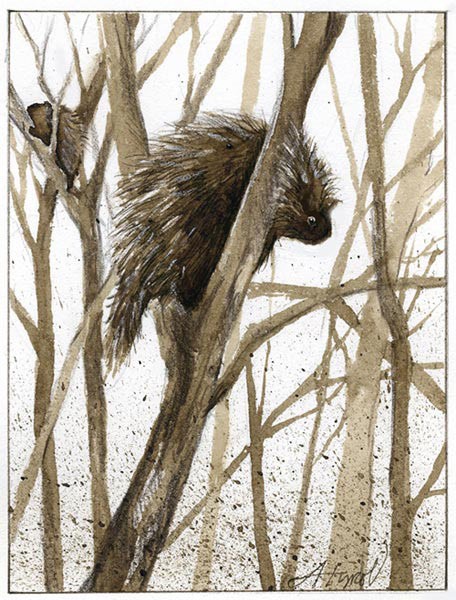
In November, as the last colors of autumn are fading, the stark outlines of tree branches are revealed. During this time you might be lucky enough to see an occasional dark mass, looking from a distance like a burl. Recently, on a hike through a dense forest, I spied one such anomaly high up in a white ash tree. Walking closer, I saw that this shape was a porcupine. It seemed asleep. After circling the area looking for quills and other markings, I shuffled noisily away. When I turned back, the porcupine was heading further up the tree. The branch it clung to bent precariously as the wind picked up, but the tenacious climber hung on.
What was the porcupine doing up so high? It may have been foraging, although white ash bark is not a favorite porcupine food. It may have simply been taking refuge. Or maybe it was seeking some much needed peace and quiet after a wild night of mating.
Porcupines have exceptional mating habits. In late autumn, when most rodents are bedding down for the winter or rushing to top off their winter caches, porcupines (usually solitary animals) begin seeking each other out. These unions can take place in the tree tops or on the forest floor, and are often accompanied by bizarre sounds.
Porcupines whine, moan and grunt, and also engage in battle chatter, a strident sound made by clicking their teeth. During mating season, both males and females make these sounds, along with wails, shrieks, and siren-like screaming.
For a male porcupine intent on winning his mate, success requires patience, perfect timing, strength, and perseverance. A female porcupine is only fertile for eight to 12 hours a year. During this time, she advertises her reproductive status with distinctively scented urine and vaginal mucus as she wanders her territory, about 20 acres, which she defends against other females. Males can roam up to 250 acres during mating season, an area about five times the size of their normal home range.
The male follows the female’s olfactory trail to find her. Rival males may fight over a female for hours. They attack each other with their incisor teeth and razor sharp quills. (A porcupine is equipped with approximately 30,000 quills, a veritable stockpile of ammo).
These fights can result in serious injury and even death. Uldis Roze, author of The North American Porcupine, told me that he once interrupted a fight where one losing male was left hanging upside down at the very end of a branch. Another was missing an ear.
The victorious male is rewarded with the opportunity to mate. If the mating takes place in a tree, the male will nudge the female forward on her branch, sniffing to smell when she is ready. The female will make small, sharp, squawking noises as she inches away. This behavior may go on for days. When the female is finally receptive, the male approaches on his hind legs and tail, grunting in low tones. He sprays a heavy stream of urine over her body and head. She then elevates her hind quarters and curves her tail over her back, exposing the under surface of the tail, which has no quills. They may continue to have repeated copulations over several hours, interspersed with periods of cleaning and rest. Eventually, the female climbs on to another branch and screams back at her mate to end their union.
A female is pregnant for seven months and then gives birth to only a single baby, which weighs around one pound. Like cats, the young are wrapped in a caul that the mother must lick off immediately, for within an hour the baby’s quills begin to harden. Sitting upright on her tail and hind legs, the mother nurses her young while the baby coos, squeaks, grunts and smacks its lips. Nursing continues for up to 125 days. Along with the milk, the baby also consumes the early spring leaves of trees, often making little whirring noises, sounding much like a kazoo. While the mother forages up in the trees, the baby stays on the ground, sleeping under a rock ledge, log, or in the hollow base of a tree. They come together again at night.
A porcupine can have a lifespan of anywhere from five to 30 years, during which the female spends 11 months of every year either pregnant or nursing. She has no years off for recovery. That’s one heck of a devoted mother.


Discussion *